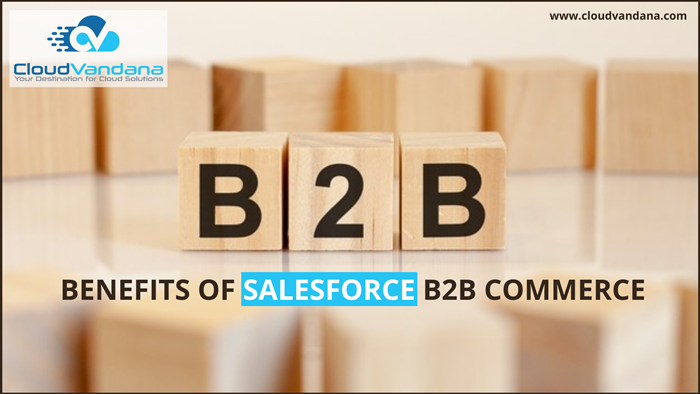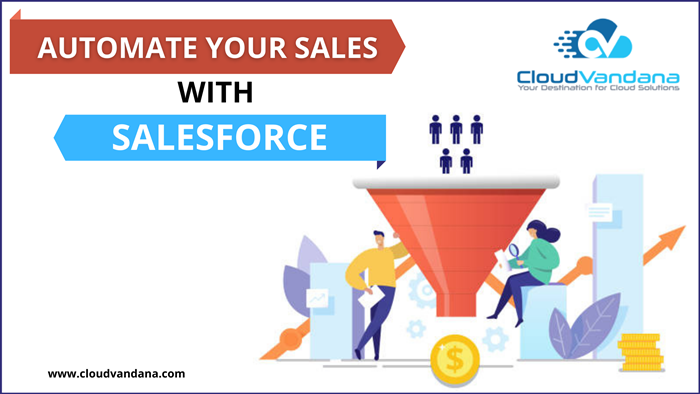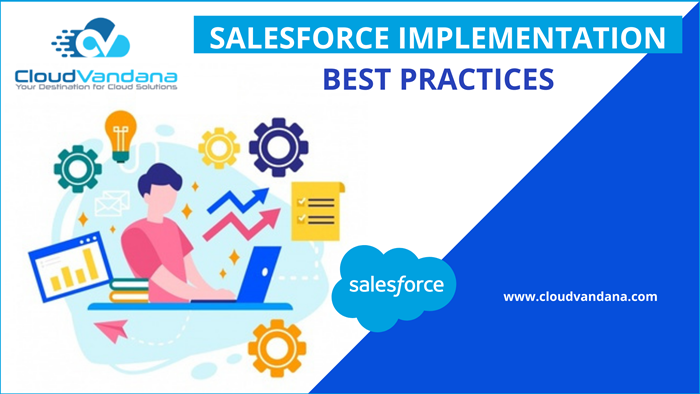KEY ROLES AND RESPONSIBILITIES OF A SALESFORCE CONSULTING PARTNER

The Salesforce Consulting Partner like CloudVandana is an expanding ecosystem that includes companies of all sizes offering the customers unique expertise across Salesforce integrations, maintenance, products, and many other abilities. This no #1 CRM helps organizations to increase the conversion rate and sales revenue. The most crucial functionality of Salesforce is that it strengthens the relationship between the organization and the customers to make the way easier for success. In this article, CloudVandana will discuss the roles and responsibilities of a consulting partner to add extra value to any business. An expert consulting partner provides appropriate solutions to the organizations, boosts revenue, and helps the businesses to stay one step ahead of the competitors. Why Do You Need A Salesforce Consulting Partner Though Salesforce implementation is accessible and user-friendly, hiring a registered consultant is always recommended to avoid any challenges regarding implementation and maintenance. For example, a wrong performance can lead to many errors that affect the organizational workflow. So organizations can hire an expert who knows the Salesforce ecosystem better and gives the total return on the Salesforce investment. Consultants customize the CRM solution as per the business requirements and goals. Then, a consulting Partner uses its expertise to adopt and support the employees with the essentials. Let’s focus on the roles and responsibilities of a Salesforce Partner. 1. Communication for a Better Understanding A registered Partner makes a bridge to build a solid and long-term relationship with clients. Communication is the only way to convey ideas and solutions to the customers. They have excellent knowledge and expertise to solve any doubts of the customers. Registered consulting partners maintain the communication and suggest better plans to improve the business. 2. Client Relationship Management After transparent communication, the next job of a Salesforce Partner is to maintain a long-term relationship with the customers. They play the role of a middleman or bridge between the organization and the clients. They also analyze the negative points that sometimes lead to decreased audience engagements. This analysis helps them retarget customers and bring them back to the sales funnel. This retention process insists the customers renew their account with the organization, and they turn out to be the satisfied, loyal customers getting the total ROI on their Salesforce investment. 3. Well Executing The Project Plans Consulting partners have excellent planning skills as per the organizational needs and size. They utilize the working hours effectively, create a timeline for various projects, and efficiently cross any problem. They schedule meetings with clients to deliver a straightforward process for transparent insight into the projects. Depending on the discussion, they manage to build the right solution efficiently in Salesforce Ecosystem. 4. End-to-end support A registered consultant provides end-to-end solutions to organizations or clients from design to deployment. They design the project plan, implement it, train the employees to adopt the new CRM system, and deploy the solution after completion. As a result, companies can focus on the other areas leaving the whole CRM responsibility to a partner organization like CloudVandana. Salesforce is an ongoing process; it requires an update in a specific time interval to experience seamless integration benefits. Are you looking for a registered Salesforce partner to experience all these benefits? Please schedule a consultation call with CloudVandana and hire expert IT resources. Request a Free Consultation YOU MIGHT ALSO LIKE
5 KEY BENEFITS OF SALESFORCE B2B COMMERCE

Salesforce B2B commerce refers to the seamless experience while purchasing a product or taking a service. B2B or business-to-business is a deal or transaction between one business and another. B2B transactions are a chain process so, can be quite a hassle. Therefore, if an organization is planning to adopt the B2B process, it needs to coordinate with various sectors to keep things running smoothly. But presently, Salesforce has made things easier and easy to adopt. Today, in this blog, CloudVandana will describe the key benefits of Salesforce B2B commerce that is best suited for every industry. Salesforce provides a personalized experience to every buyer. Buyers just need to log in and they can get started with reordering, new orders, etc. Recurring buyers can reorder the previous purchase quickly from the previous purchase history. As Salesforce is the cloud-based CRM, account managers and service agents can see all the required data in one place. Picture Source: Salesforce Benefits Of Salesforce B2B Commerce 1. Easy To Scale This platform helps the organization to scale their business as per the business needs to meet new opportunities and reach out to new customers. 2. Enhanced Productivity E-commerce provides efficiencies to B2B organizations. As orders are placed online, organizations can concentrate on the seamless customer experience and track their touchpoints. As a result, productivity increases. 3. Brand Creation This Cloud platform helps any business to create an online presence. As a result, it allows companies to promote, expand, and strengthen their brand across the web. 4. Sales Enhancement The online sales process will expand the business to new customers and allow to implement cross-sell and upsell for an enhancement in the sales process. This functionality will offer various relevant suggestions to the customers and motivate them to purchase those products for more revenue. 5. Analytics Power This platform offers various analytics campaigns to evaluate performance quickly. Such campaigns are-Marketing campaigns, sales effectiveness, inventory turns, customer sales effectiveness, and audience engagement. Google Analytics can deliver accurate tracking reports, but organizations can integrate analytics with the ERP to better understand. Additionally, brands can reach out to new customers with the help of the practical tools offered by this platform. Brands can create responsive web pages and informative content to attract more potential customers and quickly convert them into customers. B2B commerce is a marketplace that is gaining popularity day by day. So if you are planning to integrate Salesforce to enhance your brand, please feel free to take a consultation call with CloudVandana and get a customized Salesforce solution as per your business requirements. Request a Free Consultation YOU MIGHT ALSO LIKE
THE KEY BENEFITS OF SALESFORCE FINANCIAL SERVICE CLOUD

Salesforce Financial Service Cloud is an integrated platform to build economically solid relationships with customers. It is considered the future of the wealth management system. This platform nurtures economic relationships better, focusing on all the customers’ needs. Today’s digital world focuses more on handling relationships with clients in a more organized and brilliant way. As a result, companies invest in customer relationships for better growth and enhancement. Salesforce has introduced various cloud platforms depending upon these requirements that boost the customer experience efficiently and efficiently. Today, in this blog, CloudVandana will narrate the benefits of the financial service cloud to serve clients better. All know that Salesforce has an immense contribution to the sales and marketing sectors. But Salesforce is not leaving behind the financial department. This platform is designed to bring revolution to the future of wealth management. Previously this cloud platform was introduced to support the wealth management system. Still, not it has turned out to be the best platform to provide a customized and automated anytime, anywhere. In addition, it helps financial experts save time and effort by automating the process of database creation or any repetitive task to focus on the more essential functions like financial advice, investment advice, etc. That helps them draw more revenue to the organization. Financial service cloud helps financial advisers automate the daily repetitive tasks, providing the 360 views of a client, connecting with clients any time remotely, managing the client’s entire financial journey. Benefits Of Salesforce Financial Service Cloud Following are the help of the Salesforce financial service cloud- 1. Increase Engagement Salesforce financial cloud enhances the engagement of stakeholders, customers, and employees to a greater extent. This platform opens up new opportunities and digital engagement to businesses. The artificial intelligence feature provides trusted analytics and moves to the next level. In addition, automation eliminates human errors making the work process more accessible. 2. Lead Tracking Lead tracking is effectively done in Salesforce financial service cloud. It comes with powerful tools that track all the leads and referrals. 3. Action Plans The Salesforce financial service cloud offers upgraded advanced action plan features that automate complex tasks to reach the goals. It also allows the organizations to get a full view of the action plan progress. 4. Analytics This platform comes with an analytics function that helps financial advisors offer more customized and personalized solutions to the clients, leading to more revenues. In addition, this functionality helps the financial organizations to edit the reports as per the business requirements. Salesforce financial service cloud is an add-on to provide an excellent customer experience and is available in various Salesforce editions. These are some of the benefits of the Salesforce Financial service cloud. This platform is a powerful tool for all financial organizations to enhance their productivity in lesser time. Implementing Salesforce financial service cloud keeps the financial advisors one step ahead of the competition. Are you planning to integrate this platform into your business organization? Please feel free to take a consultation call with CloudVandana to step into the world of new possibilities. Request a Free Consultation YOU MIGHT ALSO LIKE
KNOW THE FUNDAMENTALS OF THE PROGRAMMING LANGUAGE-PYTHON

Python is an object-oriented, high-level programming language. In addition, it has a high-level data structure aligned with dynamic typing and dynamic binding to make this language attractive for rapid application. This simple and easy-to-learn programming language increases readability and reduces the cost of program maintenance. In addition, it supports modules and packages that enhance the program’s modularity and code reuse. This general-purpose programming language is designed for various applications, including data science, software, automation, and web development. This blog, CloudVandana, will give an overview of Python and its basic functionalities. This programming language is not limited to a specific use; it is often used to build websites, automate tasks, create software, and conduct data analytics. This versatility has made it the most used programming language. Table of Contents The Functionalities Of Python 1. Data Analytics 2. Web Development 3. Machine Learning 4. Automation 5. Visualization Of Data 6. Software Testing 7. Finance YOU MIGHT ALSO LIKE The Functionalities Of Python As Python is easy to learn, non-programmers have also adopted it for everyday tasks. So, let’s look at the common uses of Python. 1. Data Analytics Data analytics is a developing field that has adopted this programming. Python for data science and analytics works wonders for programmers. In addition, the language is easy to adopt, flexible, and well-structured, helping analyze data. This language can build a wide range of various data visualizations. Moreover, it provides several libraries that help coders contribute to data analytics and machine learning efficiently. 2. Web Development It is used to develop a website’s structure. Python sends data from servers, processes data, communicates with the database, handles URL routing, and ensures security. This language offers a large number of frameworks for web development. 3. Machine Learning It is very much suited for various machine learning and artificial intelligence projects. As it is the most popular programming language, many Python machine learning and AI libraries and packages are available. 4. Automation Automation saves time and energy for the employees from doing repetitive tasks repeatedly. Developers can automate these tasks with Python. Programmers generally write codes to automate these processes, which is called scripting. This process can check errors across the system and remove duplicates in data. Even automation can be created for simple tasks like renaming files, downloading online content, and sending emails. 5. Visualization Of Data It is another popular field of this language. This programming language is very flexible; it provides various graphing libraries that are full of features. This language is beneficial for simple graphical representation or an interactive plot. Programmers can find a library for all their needs. 6. Software Testing With Python, developers can automate testing for new products or features. It contributes to software development by bug tracking, testing, etc. 7. Finance It has made an outstanding contribution to finance, specifically in quantitative and qualitative analysis. For example, it is a valuable tool in calculating asset price trends. It also automates workflows across different data sources. So, the finance industry is one of the preferred languages in Python. These are a few of Python’s various functionalities. Are you looking for experienced Python programmers for your projects? CloudVandana is one of the leading staff augmentation firms that can provide you with all the IT resources needed for the project. So please feel free to contact CloudVandana today to get started. Contact Us Request a Free Consultation YOU MIGHT ALSO LIKE
Salesforce Marketing Cloud Vs Salesforce Sales Cloud

Salesforce Marketing Cloud is a marketing platform that supports many marketing features like multi-channel campaign execution, post and pre-campaign analytics, dynamic customer journeys, etc. Salesforce Marketing Cloud supports these features with the help of Studios and Builders. Marketing cloud includes some combined solutions for content management, journey management, and data analytics. In Salesforce Marketing Cloud (SFMC), Email Studio, Social Studio, and Mobile Studio to manage and engage communication with different channels. With the help of builders, we can manage the customer’s data, content, and journey in the Salesforce Marketing Cloud platform. Now let’s discuss some benefits of the Salesforce Marketing Cloud. Key features of Marketing Cloud Data Management: In Marketing, cloud Data Extensions(tables) are used for data management. Data Extensions can be used in the form of a relational database supported by SQL. This feature and the SFMC’s ability to store different types of data gives Marketing cloud more advantages over similar platforms. Integration Capabilities: Salesforce Marketing Cloud has a very large integration capacity which allows it to store different types of data. SFMC supports various APIs like REST API and SOAP API to expand the existing information in SFMC other than the expected connection with Salesforce’s Sales Cloud and Service Cloud. Third-Party Applications: To increase the capabilities and customize the specific goals Salesforce Marketing Cloud has many third-party applications available. An example of third-party applications supported by SFMC is AppExchange. Apart from AppExchange, several other third-party applications help SFMC to expand its functionalities. Artificial Intelligence: In Salesforce, artificial intelligence is branded as “Einstein.” Einstein helps in predicting customer engagement, the best time to send a message to each customer, and so on. All these will help increase the customer’s engagement with the brand and hopefully prevent disengagement. The SFMC helps execute promotional campaigns, automated campaigns, personalized emails, triggered messages, and much more. Key features of Sales Cloud Salesforce Sales Cloud is a cloud-based Customer Relationship Management (CRM) application from Salesforce. Sales Cloud helps sales teams win more deals and understand their business in more detail. Salesforce Sales Cloud is designed to support sales, marketing, and customer service in B2B and B2C contexts. Contact Management: Sales Cloud gives complete information about the contact like previous communications, discussions, contact ID, emails so on. This feature helps to know every contact in customer accounts. By this, we will get a complete picture of the customer and how they will engage with our brand messages. In addition, the Sales Cloud uses the social media contents of the contacts to understand customer behavior. Opportunity Management: This feature helps make and change the quotes according to the sales interaction. Salesforce Engage: This feature allows to know where the revenue growth stands, alerts active leads, and creates personalized campaigns. Lead Management: This feature of Salesforce Sales Cloud helps to designate the leads to appropriate people and also to track the campaigns. Reports and Dashboards: It’s essential to understand where to change the decisions taken and the mistake made. This feature of Sales Cloud helps create dashboards that provide every information that can lead to faster decisions. Sales Forecasting: To get proper forecasting of Sales will help in revenue growth; the sales forecasting feature gives a perfect view of Sales. The forecasting done can be adjusted with the real-time data. Workflow and Approvals: The approval process has become more simplified using the visual drag and drop interface. Sales Performance Management: To get performance summaries will help improve the Sale for the future. It will help to understand the flaws where we have to work. It also helps to create a link between Sales data and Sales goals. Are you looking for a registered Salesforce Partner? Please feel free to contact CloudVandana and get the full ROI of your Salesforce investment. Request a Free Consultation YOU MIGHT ALSO LIKE
5 IMPORTANT REASONS TO USE PYTHON

Python is a high-level programming language that helps programmers to write clear and logical codes for small and large-scale projects. In addition, programmers can use this programming language to develop desktop GUI applications, websites, and other web applications. This programming language allows the programmers to focus on the primary functionality by taking care of the different programming tasks. Today, in this blog, CloudVandana will focus on the reasons to choose Python over other programming languages. Following are the reasons- Codes Are Easy to Read and Maintain Programmers should focus on the quality of the source code to simplify maintenance and updates. It allows the programmers to express concepts without inputting any additional code. It focuses on code readability and allows to insert of keywords. The easy readability and accessible coding functions help maintain the software without investing extra time and effort. Multiple Programming Model Python supports various programming models. It also supports object-oriented and structured programming. The language feature includes numerous concepts in functional and aspect-oriented programming. Dynamic system and automatic memory management features are also enabled in this program to develop large and complicated software applications. Well Suited With Other Systems Other major operating systems support this language. This language can be used to run the codes on multiple platforms. The best part of this process is that programmers do not need to recompile the code after any changes. As a result, it leads to better programming without the hassle and even without investing additional time. Powerful Library The vast and powerful standard library keeps Python ahead of the other programming languages. This functionality allows programmers to select from an extensive range of modules as per the requirements. These modules help the programmers to add more functionalities without any complex code insertion. Makes The Complex Development Easy This language can be used to simplify and develop complex and numeric applications. Furthermore, as the features facilitate data analysis and visualization, programmers can create custom big data solutions without investing additional time and effort. On the other hand, the data visualization libraries and APIs can help visualize and present data more attractively and productively. Several python developers even prefer to achieve artificial intelligence (AI) and language processing tasks. Moreover, this programming langue makes the coding and testing process easy for the developers by embracing test-driven development approach. These are some of the reasons to use Python. There are many other benefits of this language to consider. Are you planning to outsource Python Developers for your projects? Please feel free to contact CloudVandana today for experienced Python resources. Request a Free Consultation YOU MIGHT ALSO LIKE
SALESFORCE TO BOOST YOUR SALES AUTOMATION

Salesforce is the cloud-based #1 CRM solution. It is the most popular customer relationship management system in the world. The main functionality it provides is automation which helps organizations in every sector. Automation allows organizations to focus on the core business while doing the repetitive work in the backend. Companies are adopting this process to optimize and accelerate their business processes. Today, in this blog, CloudVandana will describe how the Sales Automation process works with the help of Salesforce. Every salesperson knows that taking more time to deliver the essentials to a deal can sometimes kill the deal. The sales process includes lead generation, lead nurturing, pushing them through the sales funnel, and finally increasing the conversion. Thus the revenue of a company grows. Proper coordination between all the processes eventually develops a satisfied customer. But the sales representatives need to handle many administrative tasks for a successful deal, like making quotations, replying to queries, research, etc. So they can’t manage much time to focus on the core area, sales. Instead, they become occupied with these administrative tasks that don’t generate revenue. Here comes the Salesforce automation to automate the sales process and boost revenue. Sales automation software automates repetitive tasks, reduces the sales cycle time, and closes deals faster. Automation leads to higher sales and eliminates human error, and builds credibility with customers. Data quality also gets improves without incorrect data. Sales automation also helps to provide a personalized experience to the customer, which finally leads to more conversion. Salesforce offers various products and services as a part of the Sales Cloud. For example, Salesforce offers an advanced product called Configure Price Quote (CPQ). CPQ automatically generates accurate sales quotations, nurtures the leads by sending automated emails, and helps the sales representatives by sharing access to all the documents related to the deals to communicate with the clients whenever needed. How To Incorporate The Automation Process Sometimes it is a little complicated to automate a messy sales process. So, Sales managers should identify the inability in the current Sales process. Updating the current sales process will save time and effort while incorporating automation. Automation can be added to every sales process if it is well organized. Sales automation can be customized depending on the sales team’s pain points. But before implementing the new technology, organizations need to be sure about the adoption capability of the employees first. Contribution Of Salesforce To The Automation Process This cloud platform provides various tools to automate the repetitive work of an organization. Four tools are Approvals, Process Builder, Workflow, and Flow Builder. These tools enable the sales team to automate business processes without coding. For example, these processes automate the email sending process, creating tasks, sending outbound messages to other systems, etc. Are you looking for a registered Salesforce Partner to automate your sales process? Please feel free to take a consultation call with CloudVandana and get the total ROI of your Salesforce investment. Request a Free Consultation YOU MIGHT ALSO LIKE
SALESFORCE IMPLEMENTATION BEST PRACTICES

Salesforce is the leading CRM (Customer Relationship Management) solution provider with unlimited possibilities. Salesforce aims to manage complex business challenges and enhance businesses. But to get all the benefits, organizations need to implement Salesforce properly; otherwise, companies cannot touch the desired goal. In this blog, CloudVandana will discuss the best practices of Salesforce and the stages involved in this implementation process. Though the implementation process is user-friendly, still, it is highly recommended to hire a registered Salesforce partner for a successful implementation. The time taken in this implementation process depends on the requirements and size of the organization. Generally, it takes 15-20 days, but this span can be extended for a more customized and intensive implementation. Before going for an implementation process, organizations need to understand the basic steps and strategies involved. This understanding will help the organization increase speed and reduce costs. Following are the best practices and strategies to implement Salesforce for an organization. 1. Planning Planning is the first step involved in any process. So similarly, for Salesforce implementation, proper planning should be there depending on the needs and scalability of the organization. The implementation process mainly depends on the type of business. So for B2B or B2C companies, the implementation process should be based on the customers’ pain points so that a customized solution can be delivered. 2. Set The Timeline After the planning, organizations need to set the timeline to avoid the project overlapping. So maintaining a project schedule is very much essential. In addition, admins can target short-term achievements for better implementation assessments. These short-term goals will help to achieve significant milestones. 3. Calculate The Cost For a successful implementation, organizations need to calculate the cost related to the performance to calculate the ROI correctly. The implementation cost includes consultation fees of the registered Consulting Partner’s consultation fees and data migration and customization expenses. In addition, after the successful implementation, training program costs and maintenance charges should be added to the list. Organizations can select the Salesforce edition depending on the number of users in the organization. There are four editions available- Sales Essentials, Professional, Enterprise, and Unlimited. In addition, organizations can select based on their needs and budget. 4. Set The Goal Admins should set significant goals and objectives depending on the organizational workflow. The goals should be measurable, time-based, and realistic. 5. Deploy Before the deployment, admins can customize the CRM solution as per the organizational process. But it is highly recommended to keep the first deployment as simple as possible. Then, added features can be included in the ecosystem whenever needed later on based on customer feedback. The admins should coordinate with the users in the organization to help them overcome the challenges and adopt the new ecosystem. 6. Training For Proper Adoption After the successful implementation, companies should conduct a training process for successful adoption and running the CRM without any human error. These were the basic implementation processes. But there are many other steps involved in post-implementation. For example, Salesforce releases three updates per year to enhance user experience. Therefore, organizations should update the editions with all three outs with the help of the Salesforce consulting partners to avoid any unnecessary complications. Are you looking for a registered Salesforce partner for a successful Salesforce implementation? Please feel free to contact CloudVandana for all your Salesforce needs and get the total ROI of your Salesforce investments. Request a Free Consultation YOU MIGHT ALSO LIKE
OUTSOURCING AND ITS VARIOUS STAGES

Outsourcing is a very well-known way to boost the productivity of an organization. This augmented process can be segmented into different categories per organizational needs. In this article, CloudVandana will describe the various types associated with this process and give a detailed description of the offerings of this hiring process so that companies can decide which model suits them the best. Outsourcing It is a business process of hiring a third party outside an organization to perform services for a specific term traditionally performed by in-house employees and staff. It is a practice undertaken by companies as a cost-cutting measure. This process cuts costs and frees up time to focus on more essential areas or tasks to achieve the target. This process is of four types. Let’s have a look at the various segments of outsourcing. Onshoring Onshoring is the process of sourcing or relocating an organization’s production operation or resources within domestic and national borders. It is the practice of getting an external team to help in the work process from the same country. The benefits of onshoring are- However, this hiring process has a significant drawback: no cuts in the organization’s cost. Offshoring Offshoring is a business process from one country to another. It is getting an external team from a distant land to help in the organizational process. It is a well-known and widespread practice among multinationals as well as startups. The essential benefits of this process are as follows- Though this is not a big drawback, the outsourcing process can differ in style and structure. But with time, these differences go away. Nearshoring Nearshoring hires an external team to help in the organizational process, but the team is located in a neighboring country or a country within the same region. The benefits of nearshoring are as follows- This process has a few drawbacks, like different work cultures and lack of clear communication. But again, these challenges can be overcome in the practice of a few months. After discussing the three segments of this process, CloudVandana focuses on the fourth process. Staff augmentation. Please go through another blog on Staff Augmentation by CloudVandana. Staff Augmentation Staff Augmentation is an outsourced process used to complete a project or any other organizational process and respond to the business objectives. The technique evaluates the existing staff and determines the additional skills to include depending upon the business needs. It may leverage existing resources as well as utilize outsourced services. It is mainly the process of hiring highly skilled contractors who may come from anywhere to enhance a business, boost their specific expertise, and contribute to a particular task within the allotted time. Staff augmentation is specifically recommended for short-term projects. So, these were the overview of the various services offered through its outsourced process. Are you looking to hire outsourced resources for your organization? CloudVandana provides staff augmentation services on technologies like Salesforce, Java, Python, PHP Laravel, React JS, and Node JS. We can help you solve cost-effectiveness and quality with the help of the offshore team and on-demand technical workforce. Call us now. Request a Free Consultation YOU MIGHT ALSO LIKE
What Is Salesforce Data Migration?

Salesforce Data migration is the process of transforming CRM data from one computer storage system to another. If the Salesforce data needs to be used in some other platform, what is the way to avail it? Moving Salesforce Data to other platforms where it is required is known as Salesforce Data Migration. Salesforce Data Migration is not an easy task. However, it is a core task for any data storage professional’ You should understand the structure of the data to be migrated; in addition, the process of Salesforce Data migration has to be carried out step by step methodically. During data migration, there is an opportunity to cleanse the data. The migrated data should have some characteristics like Accuracy(Details should be accurate), Relevancy (only the information needed should be migrated ), Accessibility (the data once migrated should be available whenever required), and Uniqueness (no duplication of data should exist). Why is Data Migration Important? There are so many benefits of Salesforce Data migration. Whatever may be the exact target of the data migration, generally, data migration should be to improve productivity and performance. Data Migration is a critical component to upgrade the storage and server. It also helps to update the data-intensive applications like databases and data warehouses. Salesforce Data migration also helps to reduce storage costs. Finally, to reduce unwanted interruptions, data migration helps. To get the benefits of Salesforce Data Migration properly, a few points need to be considered. Best practices in Salesforce Data migration Identify the data to be migrated. It is essential to determine the scope of the project. There should not be any confusion on what data to be migrated. For example, it should be decided first that the contact information of each account should be relocated or all account information of a specific contract should be migrated. We should handle what data should be migrated, then document existing and the targeted formats. Create and commit a proper Data governance plan. An essential part of the migration is to address the compatibility of the migration plan. All the stakeholders should be on the same page about the data migration. So it’s essential to create a proper data governance plan and commit it. The data to be migrated may be encrypted or might need specific requirements to be handled before migration. These requirements should be addressed before the data migration process is initiated. In addition, there should be done that the data migrated to an enterprise should fit into their data management strategies. Create templates for the data and populate it. Once the data to be migrated is decided, we have to create excel templates for each data to be migrated. Then, from Data Loader using data export templates can be made. The next step is to populate the templates created. Before settling the templates, the data should be reviewed to avoid further delays. For example, one record can be loaded and check the results. If it gives the expected result, you can continue with other data. Decide the time frame for the migration. Good planning is necessary to reduce the delays and disturbances that can occur during migration. The data should be moved with minimal disruption to the current business operations. A realistic date should be set for the migration. If the planning is done carefully, it can avoid unwanted delays and cost overruns. Monitor and validate the data migrated. Constant monitoring is required to ensure that the data migrated meets the standard set. Also, a check should be done to ensure that all data has been completely and accurately migrated. It can be done using any integration tool which will alert you if any data issues are identified. Another way to validate the data is to run the expectation reports and check what information is migrated. Are you looking for a data migration process for your organization? Please feel free to contact CloudVandana to get started. Request a Free Consultation YOU MIGHT ALSO LIKE






